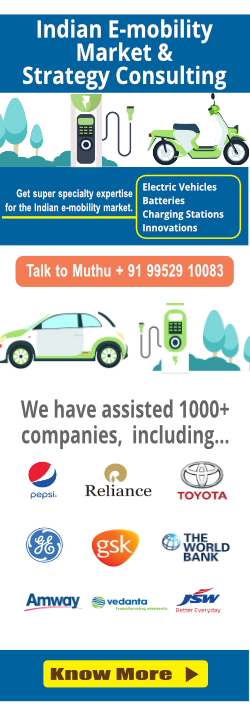This post is a part of EV Next’s EV Perspectives. EV Next, a division of EAI, is a leading market intelligence & strategic consulting firm for the Indian e-mobility sector.
It has been mentioned time and time again, by pretty much all stakeholders, that the biggest challenge to mass market electric vehicle adoption in India is price. When our EV Next team came across, earlier today, yet another news report inferring the same, we felt we should put down our thoughts on this.
Because, we quite disagree that the biggest challenge to mass adoption for electric vehicles is price. We are not saying price is not a challenge, based on our interactions with a wide section of the Indian EV stakeholder sectors (including end users) we are saying price is not the biggest challenge to EV adoption by the mass market.
So what indeed is the biggest challenge that is preventing EVs from taking off in the mass market?
The biggest challenge is that EVs are not solving any existing pain point for the mass market.
As simple as that.
Marketing 101 says a product will sell well if it either solves a pain point very well, or if it provides significant tangible/intangible benefits, let’s call them “pleasure points” (Eg: Cost savings, aesthetics of iPhones, Facebook Likes…).
The mass market just wants to get from here to there in a convenient way, and are hardly worried about their contribution to pollution or climate change. So, the need/pain point for this segment can be bluntly defined as “need for convenient transport”.
For this market, the benefit or “pleasure point” has to be quite tangible (Eg: beauty, cozy…) and not some subtle stuff (Eg: “I’m green” vibes) – that’s just Maslow’s hierarchy of needs at work.
Now, think again.
Do electric vehicles solve any pain point for the mass market?
The best of electric vehicles provide the same speed, similar comfort, convenience and range as their conventional counterparts. So what pain point indeed are they solving for this target segment that are not being solved by conventional vehicles?
None. And added to this, they come with uncertainties on charging time, range, awareness etc.
Do the current electric vehicles provide any benefit or “pleasure” point for this segment?
We can think of two possible benefits, so let’s analyse each.
Economic benefits: In theory, electric vehicles actually provide an economic benefit to the end user because the total cost of ownership of an electric vehicle over its lifetime is lower than that for a conventional vehicle. But as the mass market segment is more concerned about upfront cost than the lifetime cost, this benefit does not actually translate to perceived value in practice.
“Cool” benefits: Most electric vehicles aimed at the mass market are plain vanilla vehicles that just happen to run on batteries instead of on petrol or diesel. We can’t think of anything really “cool” about EV products produced for these segments. Companies such as Ather do have sexy vehicles (electric scooters) with attractive technical gizmos attached, but these make the vehicle considerably expensive (more than twice that of the conventional vehicle) – and thus they are targetted more at the premium market.
The real challenge is that EVs currently are not solving any pain point for the mass market, nor are they providing a benefit that this market appreciates
You tell us…
So, you tell us, when an electric vehicle neither solves a pain point nor provides a benefit to the mass market, why are we considering price as the biggest challenge?
In our opinion, we first need the mass market to start thinking of buying electric vehicles. The question of price comes only post that!
So what’s the point of this analysis?
Is this just an academic analysis? Perhaps, or perhaps not. There could be some interesting takeaways from this.
Takeaway 1. Thinking seriously, or perhaps counter-intuitively, to arrive at a unique value proposition could significantly increase market penetration
What if the OEMs are indeed able to solve a unique pain point with electric vehicles that conventional vehicles don’t solve? Can they really?
Here’s a counter-intuitive idea we can think of in this context: Projecting the low-speeds of low-end electric scooters as a virtue and not a handicap.
Allow us to explain. There’s a significant portion of the mass market – housewives, school-going teenagers, seniors – who use two-wheelers for local, short distance transport. For many of them, having a vehicle that can travel at only moderate speeds (less than 30 Km/hour) could be seen as a feature that makes vehicle riding safer. (While teenagers might not consider this a virtue, their parents who buy these for them will!).
Many of these low-speed vehicles come with an added advantage – you do not need a motor licence to ride them (needed only for vehicles beyond 25 Km/hour speeds). The charging times and range are not much of a concern for these segments given the nature and distance of rides that these vehicles are used for.
Finally, these low end vehicles are actually available at costs lower than those of normal scooters.
At EV Next, we are aware that some of the early e-scooter companies sold a large percentage of their scooters to these segments even prior to 2015, which to some extent proves my hypothesis. Why cannot prominent electric scooter makers have a significant focus on this segment (currently, we doubt that they regard this segment with a lot of respect)?
We are sure that there could be other value propositions that OEMs can arrive at that solves specific pain points for the mass market if they think really seriously.
OEMs can make EVs provide select benefits to the mass market if they take efforts to empathise with the needs of many sub-segments within this large market and come up with specialized offerings, some of which could even be counter-intuitive to current thinking.
Takeaway 2. If we are not able to arrive at unique pain points that electric vehicles can solve for the mass market end users, we should turn to someone for whom they do solve a pain point.
And that someone is the government – both central and state governments. Why?
These stakeholders are responsible for reducing air pollution (state government) and greenhouse gas emissions (central government) – two challenges that have become significant pain points for the respective governments. Mass market going electric thus actually solves critical pain points for them.
So, OEMs should ask the central and state governments to substantially increase their financial incentives that will make electric vehicles attractive for the mass segment.
Now, you might say that there’s hardly any idea here, as this is something the government is already doing.
You are right, except that the government is doing it with the wrong perspective. They are providing subsidies so that end users find electric vehicles affordable. We are saying that they should do it with the perspective that providing incentives for EV purchase solves a big problem for them.
Does it matter what perspective the government has as long as the end result is a subsidy?
Yes. If the government considers subsidy as a tool to solve one of their big problems, then they will go all out to provide massive subsidies – to the end user, to the OEMs, whoever – to ensure millions buy electric vehicles. Just as China did, and still does, especially for electric scooters and electric bicycles. Such large subsidies have made China the electric vehicle capital of the world, with a jaw dropping 92% of all electric bicycles sold in the world being in that country in 2018. (And also significantly brought down vehicular air pollution)
On the other hand, when the government thinks they are providing the end user a benefit through subsidies, they get stingy and fussy, resulting in a subsidy that does not move the needle much.
In the context of EV adoption for the mass market, which stakeholder has a real pain-point to be solved? It is the government.
So: The summary we wish to convey is:
For the current timeline (2020-2022):
- Price is not the biggest challenge for electric vehicle sales for the mass market; the lack of a USP for that segment is. If an OEM is able to come with such a USP for the mass market, it can achieve significant market penetration.
- Conversely, if EV OEMs are not able to come up with USPs valued by mass market, the only way to significantly increase electric vehicles for this segment will be through MASSIVE – and not marginal – government incentives and subsidies.
Do let us know what you think about my reasoning.
==
This post is a part of EV Next’s EV Perspectives. EV Next, a division of EAI, is a leading market intelligence & strategic consulting firm for the Indian e-mobility sector.
Know more on how EVNext can assist your business in your strategy for the e-mobility and electric vehicles sectors, from here. Know more.




 Retaining Great Talent in Fast-Growing Startups: Illumine Industries’ Approach
Retaining Great Talent in Fast-Growing Startups: Illumine Industries’ Approach




